 In our current environment we see suffering everywhere as a result of the Coronavirus pandemic. How do we understand suffering and work with suffering from a yogic point of view? What do the Yoga Sutras have to teach us about suffering? This article will discuss the philosophy of suffering and focus on Kriya Yoga as a practice which we can use to resolve our suffering. It is a simple practice and I have found it to be very effective for the time in which we live.
In our current environment we see suffering everywhere as a result of the Coronavirus pandemic. How do we understand suffering and work with suffering from a yogic point of view? What do the Yoga Sutras have to teach us about suffering? This article will discuss the philosophy of suffering and focus on Kriya Yoga as a practice which we can use to resolve our suffering. It is a simple practice and I have found it to be very effective for the time in which we live.
The Cause of Suffering: The Great Mistake
We need suffering in order to see the path. The origin of suffering, the cessation of suffering and the path leading to the end of suffering are all found in the heart of suffering. If we are afraid to touch our suffering, we will not be able to realize the path of peace, joy and liberation. Don’t run away. Make peace with it. The Buddha said:
“The moment you know how your suffering came to be, you are already on the path of release from it. —Thich Nhat Hanh
Buddhism has much to teach us about suffering and Patanjali incorporated many of its teachings within the Yoga Sutras. The Four Noble Truths of Buddhism are embodied within the Yoga Sutras (Note: all citations from the Yoga Sutras are from: The Yoga Sutras of Patanjali, Translation & Commentary by Sri Swami Satchidananda).
- The First Noble Truth is the inevitability of suffering; suffering is baked into the human condition. In Yoga Sutra 2.15, Patanjali tells us that, “To one of discrimination, everything is painful indeed, due to its consequences: the anxiety and fear over losing what is gained; the resulting impressions left in the mind to create renewed cravings; and the constant conflict among the three gunas, which control the mind.”
- The Second Noble Truth is the origin of suffering. The direct causes of suffering are attachment, aversion, and ignorance. These are often referred to as the three poisons of the mind. In the Yoga Sutras, the root causes of suffering are the kleshas (obstacles). Yoga Sutra 2.3: “Ignorance, egoism, attachment, hatred and clinging to bodily life are the five obstacles.”
- The Third Noble Truth is the cessation of suffering by refraining from doing things that make us suffer. In Yoga Sutra 2.16, Patanjali says: “Pain that has not yet come is avoidable.” There is a way out of suffering.
- The Fourth Noble truth is the path that leads us out of suffering. The Noble Eightfold Path is Right Views, Thinking, Speech, Action, Livelihood, Diligence, Mindfulness, and Concentration. This is similar to the eight limbs of Yoga. Kriya Yoga is another set of practices that resolves suffering.
The Three Levels of Suffering
There are three basic levels of suffering. The first level of suffering is the obvious physical and mental sensations of pain and discomfort that we identify as suffering. This is primarily at the sensory level: painful sensations and feelings.
The second level of suffering is suffering over impermanence. Although certain experiences may seem pleasurable now, we will suffer later because they will not last. In fact, the more we pursue pleasant experiences, the greater will be our level of disillusionment and unhappiness.
Buddhism’s teaching of the “Five Remembrances” highlights the truth of impermanence. They are translated here by Thich Nhat Hahn:
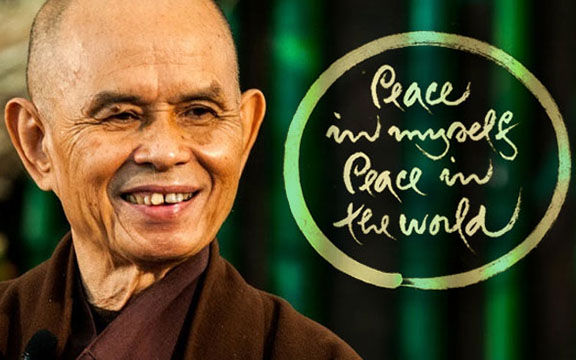
(photo: Thich Nhat Hahn)
I am of the nature to grow old.
There is no way to escape growing old.
I am of the nature to have ill-health.
There is no way to escape having ill-health.
I am of the nature to die.
There is no way to escape death.
All that is dear to me and everyone I love are of the nature to change.
There is no way to escape being separated from them.
My actions are my only true belongings.
I cannot escape the consequences of my actions.
My actions are the ground on which I stand.
The third level of suffering is spiritual ignorance. We automatically identify with our egoic self which is ruled by ever-changing memories, emotions, and thoughts. It is the voice in our minds that never stops talking. The ego’s function is not to make us happy but to protect us and allow us to navigate the world. It tends to make us anxious and unhappy because it acts out of fear. We do not realize that our true Self is who we really are and its state is permanent and blissful. We are not our egos. This fundamental confusion over our true identity is spiritual ignorance and, as we will see, is the root cause of all suffering.
The Klesas (the Afflictions)
In Sanskrit, the word for affliction is klesa (literally, “that which afflicts from within”). They are the root cause of suffering. If we observe our experiences, we can discover the role that afflictions play in our day-to-day lives.
The klesas are spiritual ignorance (avidya), egoism (asmita), attachment (raga), aversion (dvesa), and clinging to life (abhinivesah).
Yoga Sutra 2.4 states the causal role of spiritual ignorance: “Ignorance is the field for the others mentioned after it, whether they be dormant, feeble, intercepted or sustained.” There are five klesas mentioned in the Yoga Sutras. Four of them grow out of the first, which is avidya, or spiritual ignorance. Avidya is known as the garden in which the weeds of affliction grow.
In his book, The Essence of the Heart Sutra, H. H. the Dalai Lama explains:
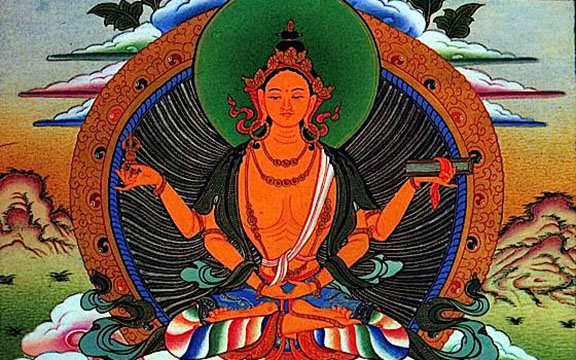
(photo: Prajnaparamita)
In truth, it is always and only the mental afflictions that agitate our minds, yet we tend to blame our agitation on external conditions, imagining that encountering unpleasant people or adverse circumstances makes us unhappy. However, as the great Indian Buddhist teacher Shantideva pointed out around the eighth century, when true practitioners of the Buddha’s teaching encounter adversities, they remain resolute and unmoved, like a tree.
Shantideva reminds us that encountering adversity, in itself, does not necessarily lead to a disturbed mind; even amid adversity, the principal cause of our unhappiness is our own undisciplined mind under the influence of the klesas. Failing to understand this principle, we allow ourselves to be controlled by the mental afflictions; in fact, we often embrace and reinforce them, for instance by adding fuel to our anger.
Avidya (Spiritual Ignorance)
The Sanskrit word for spiritual ignorance is avidya. Yoga Sutra 2.5 defines avidya this way: “Ignorance is regarding the impermanent as permanent, the impure as pure, the painful as pleasant and non-Self as the Self.”
Christopher Isherwood gives a poetic view of avidya:
Ignorance is false identification. It is a misunderstanding of one’s real nature. Pure, eternal joy and peace are to be found only in union with the Atman. Our ignorance debars us from that union, but the dim, confused longing for happiness remains. So we are driven to seek it in the external world. We are forced to accept substitutes and to try to persuade ourselves that they are genuine and valid. Instead of eternity, we cling to what seems relatively enduring. Instead of purity, we value what seems relatively pure. Instead of true happiness, we clutch at what seems temporarily pleasant. But, also, our satisfaction is short-lived. The strongest tower falls, the most beautiful flower withers in our hands, the clearest water turns polluted. Ignorance has betrayed us, as it always must. Yet, as we turn sadly away, our eyes fall upon some new object of sense attachment and desire. And so the hopeless search goes on.
Swami Karunananda explains avidya this way:
The klesas are the basic afflictions of the mind. Primary among them and the root cause of all suffering is ignorance of our true nature or avidya. We forget our true nature, the divine Spirit within us, that is ever peaceful and joyful, which Patanjali refers to as Purusha or Atman. As if that were not bad enough, we think we are something else. That is where the next klesa, egoism or asmita, comes in. We identify with what is closest to us, the mind and the body, and we think that is who we are. This is problematic because, unlike our true nature, the body and mind are constantly changing. We also become attached to what is pleasurable and averse to all that is painful.
Regarding the impermanent as permanent
In his classic text Zen Mind, Beginner’s Mind, Shunryu Suzuki discusses the affliction of regarding the impermanent as permanent:
The basic teaching of Buddhism is the teaching of transiency, or change. That everything changes is the basic truth for each existence. No one can deny this truth, and all the teaching of Buddhism is condensed within it. This is the teaching for all of us. Wherever we go this teaching is true. When we realize the everlasting truth of “everything changes” and find our composure in it, we find ourselves in Nirvana. Without accepting the fact that everything changes, we cannot find perfect composure. But unfortunately, although it is true, it is difficult for us to accept it. Because we cannot accept the truth of transiency, we suffer. So the cause of suffering is our nonacceptance of this truth. The teaching of the cause of suffering and the teaching that everything changes are thus two sides of one coin.
Everything is impermanent; everything changes in time. If we do not accept this truth, we will suffer.
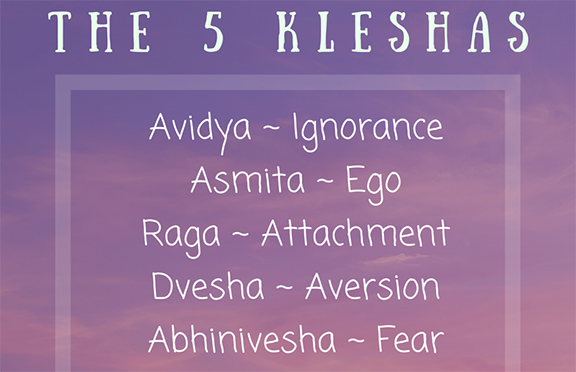 Regarding the Impure as the Pure
Regarding the Impure as the Pure
This aspect of avidya involves confusing the nature of the true Self with that of the body. The body may be viewed as painful (duhkha), unclean and temporary; it suffers from aches, pains and diseases. The Self may be viewed as joyful (sukha,) pure, and eternal. This confusion produces suffering because we are attached to our bodies which will grow old, develop health problems, and eventually die.
Confusing the Painful with the Pleasant
There are many actions that seem pleasurable in the moment but turn out to be painful later. For example, a slice of pie may be pleasurable but the whole pie is painful. This confusion produces suffering.
Asmita (Confusing the “I” with the True Self)
We identify with the ideas, thoughts, and moods that are created by our “I”. We become so identified with the voices in our mind and our suffering that we cannot recognize our true Self. The voice of our true Self speaks quietly but it is overwhelmed by cacophony of our minds. The true Self is not something that we must seek to find and possess; rather, it is something that we already have. It is so close to us and quiet that we do not see it. We just have to uncover the layers of suffering and afflictions that cover our true Self.
Raga and Dvesha: Attachment and Aversion
Yoga Sutras 2.7 and 2.8 speak to the twin afflictions of attachment and aversion.
Yoga Sutra 2.7: Attachment is that which follows identification with pleasurable experiences.” Attachment is based on memory. We grasp for pleasure because we remember our past experiences. We want to repeat them in the future. This becomes the basis for craving and attachment.
Yoga Sutra 2.8: “Aversion is that which follows identification with painful experiences..” If we perceive a thing, person, or event to be undesirable, we will react with repulsion and try to avoid it. This repulsion becomes the basis for hostility and other associated negative emotions. We can become obsessed with our dislikes.
When we are attached to something, we tend to push its opposite away with equal intensity. This process of grasping and rejecting is a root cause of suffering.
Abhinivesa (Clinging to Life)
Yoga Sutra 2.9: “Clinging to life, flowing by its own potency [due to past experience], exists even in the wise.”
It is said that even wise people suffer from this klesa. The ego may dissolve during deep states of meditation. Our reaction to this experience may feel like we have died and clinging and fear is the result. This is the ego’s fear of dissolution, its fear of losing its boundaries and of losing control. Yet if we can simply rest with the knowledge that everything is impermanent, and trust in the process of not-knowing—both are qualities integral to change—then insight into the truth of impermanence is possible. The fear of death arises because we do not understand there is something much more important than our bodies and our possessions. The freedom of the soul, the eternity of the true Self, of the Atman, is where we should place our thoughts and our faith.
Viveka: The Path to Ending Suffering
How do we end spiritual ignorance and stop suffering? The solution to the problem of ignorance is wisdom. If we can remove spiritual ignorance, we can end suffering. Viveka is the ability to discern between our true Self and our identification with our ordinary thoughts (or “I-ness”) which we mistakenly believe to be our true identity. We are not our thoughts, we are not our senses, we are not our bodies. We are the Atman, Spirit, the ground of all being. Thus, viveka is one of the keys to the entire practice of Yoga. Reverend Jaganath Carrera explains this as follows:
Ordinarily our discriminative capacity is occupied with a constant stream of pertinent and non-pertinent thoughts: perceptions of objects, events, wishes, and people flow into that consciousness. But to pierce through ignorance, to perceive the Self as our true identity, viveka requires a high order of clear, steady focus and the absence of selfish attachment. In Yoga Sutra 2.28, Patanjali teaches that we achieve viveka through the practice of the eight limbs of Yoga. Through this practice, impurities are removed, wisdom emerges and the state of viveka is realized.
Yogic wisdom burns the seeds of the klesas away and then we may rest in our true Self. How do we get this yogic wisdom? Through our Yoga practice!
The Practice of Kriya Yoga
And the day came when the risk to remain in a tight bud was more painful than the risk it took to blossom.
—Anais Nin
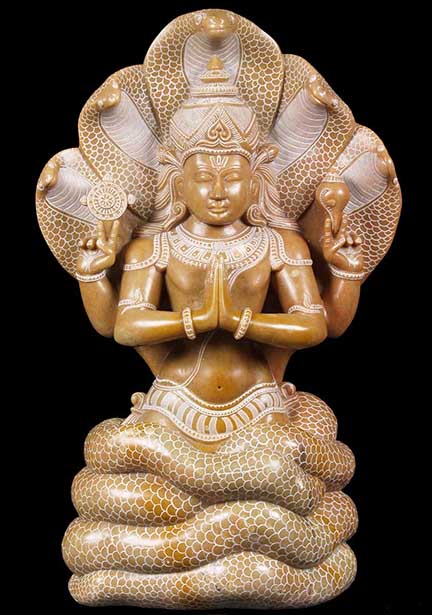
(photo: Sri Patanjali)
Patanjali describes the practice of Kriya Yoga and its result at the beginning of Pada Two of the Yoga Sutras.
Yoga Sutra 2.1: “Accepting pain as help for purification, study of spiritual books and surrender to the Supreme Being constitute Yoga in practice.
Yoga Sutra 2.2: “They help us minimize obstacles and attain samadhi.”
Kriya Yoga is the three-limbed practice. The three limbs are discipline (tapas), study (svadhyaya) and devotion (Isvara pranidhanani). Let’s look at how we can apply Kriya Yoga to work with suffering in our daily lives.
There are times when we have to face something that we find unbearable. It may be a loss, a sickness, or a death. It may be something that happens to us or that happens to someone we love. The First Noble Truth of Buddhism says that life is marked by suffering. We do not get what we want, and we get what we do not want. We have lost that which is dear to us. At some point in our lives suffering will come to us.
So how do we respond? We have a basic choice. We can respond from the perspective of ordinary, small mind, or from big mind, from either the “I” or the true Self.
Most of us default into responding from small mind. This is habitual. We know that we are responding from small mind if we shut down, repress our emotions, refuse to face the situation, or numb ourselves out with drugs and alcohol. We are no longer free to deal with the problem; we are responding out of habit and “taking the easiest way out.” This leads to bad behaviors and responses.
Kriya Yoga gives us a simple but very effective framework to respond to suffering from a spiritual point of view. It dissolves the klesas and leads us to samadhi which is the state of pure awareness of our true Self.
When we are faced with suffering, we can ask three questions presented by Kriya Yoga.
What practice do I need now? (tapas)
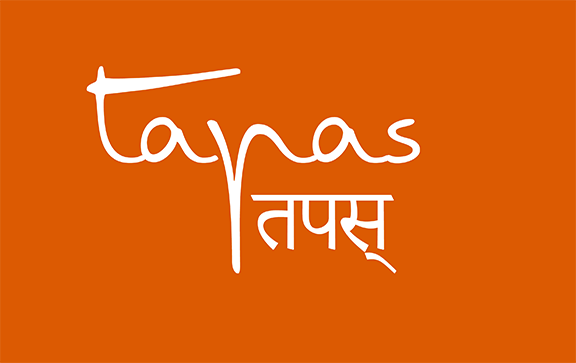 There are many Yoga practices that we can draw upon to help us through the hard times. Suffering may cause stress in our bodies. Our asana practice will relieve this stress and tension by opening our bodies and our minds. This opening can lead to insight. We may need to do some breath work to get through the really hard times of deep trauma. Pranayama will calm our minds and relax our bodies. Breath controls mind. It will energize us and help us face the situation more clearly.
There are many Yoga practices that we can draw upon to help us through the hard times. Suffering may cause stress in our bodies. Our asana practice will relieve this stress and tension by opening our bodies and our minds. This opening can lead to insight. We may need to do some breath work to get through the really hard times of deep trauma. Pranayama will calm our minds and relax our bodies. Breath controls mind. It will energize us and help us face the situation more clearly.
Perhaps we need to withdraw from our daily life for a while? Pratyahara can help us gain a new perspective and courage to deal with the situation. We may consider taking a retreat or walking in nature. Perhaps we need to spend some time in meditation? Carefully observe your reaction to the situation that caused suffering and do a deep inquiry into what practices you need now and over time to work with your suffering. We can use any of Patanjali’s practices described within the Yoga Sutras to encounter and reduce our suffering.
What is the deepest truth or wisdom beyond the situation and the emotions? (svadhyaya)
We may use the situation that produced our suffering to gain insights and truth. If we view suffering as a wisdom teacher, then what is its lesson? I am reminded of Ram Dass who, after being stricken with a stroke that left him paralyzed, ultimately realized that it was a matter of “ fierce grace” from his Guru. The suffering attached to being paralyzed was “grist for the mill” and helped propel him further down the spiritual path. He was not a person who had a stroke and who was suffering. Rather, he was witness a body that had experienced a stroke. He did not let the stroke define his life or his state of mind.
 This practice goes beyond just what we can learn from the difficult situation we are facing. It points to the wisdom of discriminating between our egoic mind which is suffering and our true Self which does not suffer. We can study the movements of our mind and see how it identifies with the suffering. Can we take a step back and observe the suffering as a witness? A mindfulness practice or a meditational practice will help us do this.
This practice goes beyond just what we can learn from the difficult situation we are facing. It points to the wisdom of discriminating between our egoic mind which is suffering and our true Self which does not suffer. We can study the movements of our mind and see how it identifies with the suffering. Can we take a step back and observe the suffering as a witness? A mindfulness practice or a meditational practice will help us do this.
When we witness our suffering, we can see that our thinking mind is the source of much of the suffering that we are experiencing. We can watch our mind tie itself up in knots, create imaginary problems and conflicts, and amplify the suffering that we are experiencing. We can see that we are identifying with the suffering. We know this because the suffering is all that we see and feel.
When we witness our egoic minds, then we create space between our witness and our thinking minds; this space opens us to a sense of peace that comes from our true Self. Even if we get a few moments of this peace, it will do much to relieve us from our suffering. And we can return to this well time after time.
Here is how Sally Kempton describes the inquiry:
Self-study might take the form of the classical yogic inquiry “Who am I?” or of witness practice, in which you step back from your thoughts and emotions and identify yourself with the witness-observer rather than with the thinker. Svadyaya is a way of moving beyond limiting beliefs to identify your basic goodness, the unbreakable beauty of your inner heart.
What or how can I surrender? (Ishvara pranidhana)
Sri Swami Krishnananda describes this branch of Kriya Yoga:
Surrender to God implies acceptance of the divine ordinance and an abolition of one’s own initiative to the extent that the seeker does not think individually but resigns himself to those circumstances which take place around him, without interfering with their occurrence. He does not wish to alter conditions but tolerates everything. He allows things to happen and does not wish to modify existence. To him, God is all. This is the essence of self-surrender in Yoga.
 This practice challenges us to think about what we need to let go of in our lives that is causing us to suffer. Do we have toxic relationships or jobs? Do we have destructive habits? Are we stuck within something that is causing us to suffer? Are we grasping after something that is irretrievably lost? It is a matter of deep inquiry.
This practice challenges us to think about what we need to let go of in our lives that is causing us to suffer. Do we have toxic relationships or jobs? Do we have destructive habits? Are we stuck within something that is causing us to suffer? Are we grasping after something that is irretrievably lost? It is a matter of deep inquiry.
We also need to consider what is keeping us from letting it go. We may know what we need to do but we are paralyzed by fear. We fear change and uncertainty. This is because we have not fully accepted the principle of impermanence and the freedom and creativity that is embodied within newness and change.
Surrender is a difficult idea for many of us to accept. This is because it suggests “giving up” or “being weak” or “being defeated.” We like to win at all costs. But by framing the practice in these terms we can already see the influence of our egos! Our egos always like to be in control and to win.
The key idea behind this practice is that it shifts our perspective from the ego and its narrow and limited concerns to divine consciousness. It connects our actions to the sacred source. This is the pathway to unity with our true Self.
Surrendering to the divine is the action of letting go of our personal desires and goals and accepting whatever is given to us by the divine. It also means dedicating the fruits of our actions to the divine without any thought of personal gain.
Swami Pujya says that one of the greatest sources of human discontent and unhappiness is our inability to accept situations that happen to us. We try to be in control of every situation. We try to “sculpt the world into our own preconceived image of what is right.” He says that the inevitable result is frustration and our lives will be marked by perspiration rather than inspiration!
This practice is about devotion to connection to your conception of the divine. This may be devotion to Jesus, Buddha, Krishna, or the Goddess. How do you practice devotion to the divine?
This is Bhakti Yoga and it may take many forms. It could be building a small altar in your home, it could be chanting mantras like OM, it could be participating in kirtan, it could be a personal ritual such as saying a blessing before a meal. It can mean dedicating your Yoga practice to the divine.
All of these practices establish a connection to the divine. The Bhagavad Gita says:
Whatever is offered to me with true devotion—
if only a leaf,
a flower, a fruit
or a sip of water—
I accept it because
it is given with love.
—The Living Gita, Chapter 9, Verse 26
These offerings will manifest in your life as an attitude of devotion. You will start seeing the divine everywhere in your daily life. You will start being attracted to places that seem to be centers of divine energy. It could be sacred architecture or powerful places of nature.
When you establish this connection with the divine you will feel that your ego begins to take a back seat. You can start to look at the world through the expansive perspective of the true Self. You feel plugged into the flow of the universe. You begin to row downstream with the current rather than always fighting the current. This does not mean that you are passive and complacent. Sometimes you need to accept the challenge, stand firm and fight through the hard times. This is why we have poses like Warrior I. But you now have an option. You have a choice. And choice means freedom.
About the Author:
 Gary Kissiah was introduced to Eastern philosophy in college when he discovered the writings of Alan Watts which led to studies in Zen and Zen-inspired poetry. Gary found Yoga in 2000 as a way to recover from back trauma and has been studying and practicing Yoga since that time. Gary has a Certificate of Yoga Philosophy from the California Institute of Integral Studies. He has studied Yoga at Satchidananda Ashram-Yogaville, Virginia, Esalen Institute, Big Sur California, and Parmarth Niketan Ashram, Rishikesh, India
Gary Kissiah was introduced to Eastern philosophy in college when he discovered the writings of Alan Watts which led to studies in Zen and Zen-inspired poetry. Gary found Yoga in 2000 as a way to recover from back trauma and has been studying and practicing Yoga since that time. Gary has a Certificate of Yoga Philosophy from the California Institute of Integral Studies. He has studied Yoga at Satchidananda Ashram-Yogaville, Virginia, Esalen Institute, Big Sur California, and Parmarth Niketan Ashram, Rishikesh, India
Gary has photographed many spiritual sites and experiences in his travels throughout Asia. After four years of study and writing, he published his first book entitled: The Yoga Sutras of Patanjali—lluminations Through Image, Commentary and Design. The book provides a new and inviting approach to studying and living the Yoga Sutras by using imagery, poetry and quotation to illuminate the heart of the Sutras. For more information: garykissiah.com

